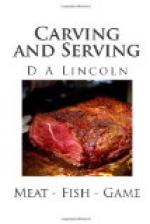Care should be taken to carve in such a way as to get the best effect. A nice joint is often made less inviting from having been cut with the grain, while meat of rather poor quality is made more tender and palatable if divided across the grain. Where the whole of the joint is not required, learn to carve economically, that it may be left in good shape for another dinner.
After you have learned to do the simplest work neatly and gracefully, much painstaking will be necessary in acquiring the power to accomplish with elegance the more difficult tasks. For to reach the highest degree of excellence in the art, one must be able to carve the most difficult joint with perfect skill and ease.
But after all this study and a great amount of practice failure often happens, and blame is laid upon the carver which really belongs to some other person,—the butcher, the cook, the table-girl, or the guest. Not all men who sell meat know or practice the best way of cutting up meat. Much may be done by the butcher and by the cook to facilitate the work of the carver. These helps will be noticed more particularly under the head of special dishes.
An essential aid to easy carving, and one often overlooked, is that the platter be large enough to hold not merely the joint or fowl while whole, but also the several portions as they are detached.
The joint should be placed in the middle of the platter, in the position indicated under special directions. There should be sufficient space on either side for the portions of meat as they are carved; that is, space on the bottom, none of the slices being allowed to hang over the edge of the dish. If necessary, provide an extra dish. The persistency with which some housekeepers cling to a small dish for fear the meat will look lost on a larger one often makes successful carving impossible.
The platter should be placed near the carver, that he may easily reach any part of the joint.
The cook should see that all skewers, strings, etc., be removed before sending the meat or fish to the table. It is extremely awkward to find one’s knife impeded by a bit of twine.
The carver may stand or sit, as suits his convenience. Anything that is done easily is generally done gracefully, but when one works at a disadvantage awkwardness is always the result.




